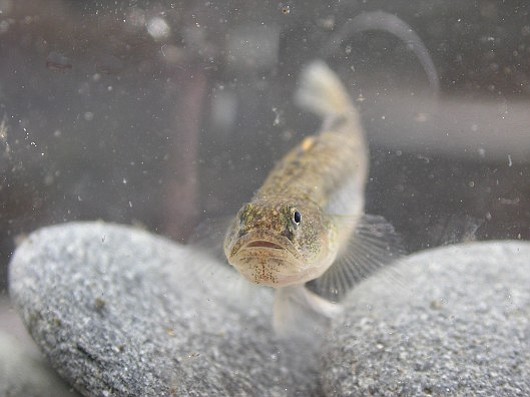 Facebook
Facebook
 X
X
 Instagram
Instagram
 TikTok
TikTok
 Youtube
Youtube

The endangered tidewater goby, native only to the California coast from Del Norte County to San Diego County, is a tiny fish. Growing up to two inches long, the species lives exclusively in coastal brackish water habitats, including streams, estuaries, and lagoons.
This year, when forecast El Niño storm surges threatened to breach tidepools and wash away portions of coastal habitat in San Diego County, UCLA graduate student Brenton Spies and a team of biologists came to help.
Spies and the team collected the fish from three locations on Camp Pendleton: San Onofre Creek, Hidden Lagoon, and Cockleburr Canyon Creek. The three sites are currently the only known locations of tidewater gobies south of Topanga Canyon Creek (near Malibu in Los Angeles County).
When 300 of the gobies arrived at Birch Aquarium on February 4th, Birch employee Melissa Torres took them in. She made them at home in the aquarium’s outside reserve tank system, where she added clean sand and fake plants “to make them as comfortable as possible.” She adjusted water salinity and created “burrows” for the fish, which like to have hide-holes, using sections of PVC pipe. She used the same methods for the tidewater goby display inside the Hall of Fishes.
Females in the display tank began to show signs of mating. Tidewater gobies are unusual in their mating habits: instead of the male being colorful and showing off to attract a mate, the female takes on a deeper hue when she’s ready to lay eggs. Males build burrows of mucous and sand, for which females compete to gain access. Biting and tail-slapping, usually male behaviors, are part of the female routine.
Though breeding them was not part of the aquarium’s task while housing the tidewater gobies, U.S. Fish & Wildlife approved raising babies in captivity with the understanding that they would eventually be released with the others.
To accommodate egg clutches in case of spawning, Torres modified the display tank to include a PVC burrow with a section of mesh. The screen would allow for easy removal so the eggs could be hatched under close care.
“In a way, this is a snapshot of our collective future as aquaria/zoos become sanctuaries for species caught up in climate change,” said Birch Aquarium executive director Harry Helling.
The tidewater gobies are expected to be returned to their coastal estuarine homes on Camp Pendleton in early May, after winter storm threats have passed and habitats are determined to be more stable.


The endangered tidewater goby, native only to the California coast from Del Norte County to San Diego County, is a tiny fish. Growing up to two inches long, the species lives exclusively in coastal brackish water habitats, including streams, estuaries, and lagoons.
This year, when forecast El Niño storm surges threatened to breach tidepools and wash away portions of coastal habitat in San Diego County, UCLA graduate student Brenton Spies and a team of biologists came to help.
Spies and the team collected the fish from three locations on Camp Pendleton: San Onofre Creek, Hidden Lagoon, and Cockleburr Canyon Creek. The three sites are currently the only known locations of tidewater gobies south of Topanga Canyon Creek (near Malibu in Los Angeles County).
When 300 of the gobies arrived at Birch Aquarium on February 4th, Birch employee Melissa Torres took them in. She made them at home in the aquarium’s outside reserve tank system, where she added clean sand and fake plants “to make them as comfortable as possible.” She adjusted water salinity and created “burrows” for the fish, which like to have hide-holes, using sections of PVC pipe. She used the same methods for the tidewater goby display inside the Hall of Fishes.
Females in the display tank began to show signs of mating. Tidewater gobies are unusual in their mating habits: instead of the male being colorful and showing off to attract a mate, the female takes on a deeper hue when she’s ready to lay eggs. Males build burrows of mucous and sand, for which females compete to gain access. Biting and tail-slapping, usually male behaviors, are part of the female routine.
Though breeding them was not part of the aquarium’s task while housing the tidewater gobies, U.S. Fish & Wildlife approved raising babies in captivity with the understanding that they would eventually be released with the others.
To accommodate egg clutches in case of spawning, Torres modified the display tank to include a PVC burrow with a section of mesh. The screen would allow for easy removal so the eggs could be hatched under close care.
“In a way, this is a snapshot of our collective future as aquaria/zoos become sanctuaries for species caught up in climate change,” said Birch Aquarium executive director Harry Helling.
The tidewater gobies are expected to be returned to their coastal estuarine homes on Camp Pendleton in early May, after winter storm threats have passed and habitats are determined to be more stable.
Comments